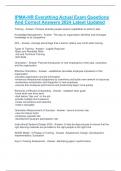IPMA -HR Everything Actual Exam Questions And Correct Answers 2024 Latest Updated Training - Answer -Process whereby people acquire capabilities to perform jobs Knowledge Management - Answer -The way an organization identifies and leverages knowledge to be competitive 20% - Answer -Average percentage that a learner retains one month after training Types of Training - Answer --Legally Required -Basic and Remedial Skills -Job and Technical Training -Soft Skills Orientation - Answer -Planned introduction of new employees to their jobs, coworkers, and the organization Effective Orientation - Answer --establishes favorable employee impression of the organization -provides organization and job information -enhances interpersonal acceptance by coworkers and builds new network of resources -accelerates socialization and integration of new employee -ensures that employee performance and productivity begin more quickly Elements of Effective Onboarding - Answer --establish clear goals -know what new hires want -start before "day one" on the job -provide multiple short sessions -create connections and networks -make it enjoyable Orientation Measurement of Success - Answer --tenure turnover rate -new hire failure factor -employee upgrade rate -development program participation rate Instructional Systems Design (ISD) - Answer -A step -by-step process to ensure t hat the right learning materials are provided to the right people at the right time. ADDIE Model - 5 Phases of Training - Answer -Assessment, Design, Development, Implementation, Evaluation Key to Training Assessment - Answer -Identifying gaps in performance Effective Training Planning - Answer --is there really a need for the training? -who needs to be trained? -who will do the training? -what form will the training take? -how will knowledg e be transferred to the job? -how will the training be evaluated? 4 Ways to Effectively Train Employees - Answer -1-Blend in -person training and online training 2-Provide hands -on training 3-Incorporate mobile training apps 4-Allow employees to learn at t heir own pace How to Diagnose Training - Answer -Analyze organizational outcomes and look at future organizational needs 4 Ways to Measure Training Effectiveness - Answer -1-Learner reaction 2-Measuring gain in knowledge or skill 3-Measuring increased pe rformance back in the workplace 4-Impact on the organization itself Sources of Information for Needs Assessment - Answer --organizational analysis -job/task analysis -individual analysis Organizational Analysis - Answer -Grievances, accidents, waste/scra p, training observations, customer complaints, exit interviews, equipment use, attitude surveys Job/Task Analysis - Answer -Employee KSAs, benchmarks, effectiveness, job specs, efficiency data, employee surveys Individual Analysis - Answer -Performance appraisals, tests, records, assessment centers, questionnaires, surveys, job knowledge tools Focuses for Training Objectives - Answer --knowledge -skill -attitude Training Design Elements - Answer --learner chara cteristics -training transfer -instructional strategies Learner Characteristics - Answer -Ability to learn, motivation to learn, self -efficacy, perceived utility/value, learning styles Training Transfer - Answer -Overview of training content, strategic l ink, supervisor support, opportunity, accountability Instructional Strategies - Answer -Practice/feedback, over -learning, behavioral modeling, error -based examples, reinforcement/immediate confirmation Self-Efficacy - Answer -People's belief that they ca n successfully learn the training program content Andragogy - Answer -Adult learning; ways in which adults learn differently than do younger people. 5 Principles for Designing Training for Adults - Answer --need to know why they are learning something -need to be self -directed -bring more work -related experiences into the learning process -enter into a learning experience with a problem -centered approach to learning -are motivated to learn by both extrinsic and intrinsic factors Active Practice - Answer -Trainees perform job -related tasks and duties during training Behavioral Modeling - Answer -Copying someone else's behavior Reinforcement - Answer -Based on the idea that people tend to repeat responses that give them some type of positive reward and to avoid actions associated with negative consequences Immediate Confirmation - Answer -Based on the idea that people learn best if they receive reinforcement and feedback as soon as possible after training Training Delivery Options - Answer --internal to the organization -external to the organization Internal Training Options - Answer -Traditional classes, on -the-job training, s elf-guided training at company portal, mentoring/coaching, job shadowing, developing teachers internally, cross training, training projects, group -based classroom External Training Options - Answer -Third -party delivered training, web conferences, trainin g at outside location, podcasts, educational leave, blended training, teleconferencing Advantages to External Training - Answer -Less expensive, less time to develop internal training, staff may not have the level of expertise needed, employees can learn from other companies Informal Training - Answer -Training that occurs through interactions and feedback among employees Common Forms of Instructional Techniques - Answer --on-the-job training -apprenticeships -simulations -case studies -games and activit ies -role play -behavior modeling -computer -based training On-The-Job Training - Answer -The most common training because it is flexible and relevant Cross -Training - Answer -Training people to do more than one job Apprentice Training - Answer -Provides employee with on -the-job experience under the guidance of a skilled and certified worker Case Studies - Answer -Focus upon stories about individuals, organizations, processes, projects or events and the consequence o f decisions or actions that were taken Role Play - Answer -Enables the practice of new skills in a safe environment, open communication among participants, mandate active involvement, build individual and group confidence, develop camaraderie among partic ipants and enable the correcting of errors while still in the classroom Internship - Answer -Combines job training with classroom instruction from high schools, technical school, colleges and universities E-Learning - Answer -Use of web -based technology to conduct training online MOOCs - Answer -Massive open enrollment online courses Simulations - Answer -Reproduce parts of the real world so they can be experienced, manipulated, and learning can occur Games - Answer -Exercises that entertain and engage M-Learning - Answer -Use of mobile technology to conduct training Computer -Based Training (CBT) - Answer -Self-paced training that can be provided from a PC through the use of a CD -ROM Strategic Decisions for M -Learning - Answer --target market




